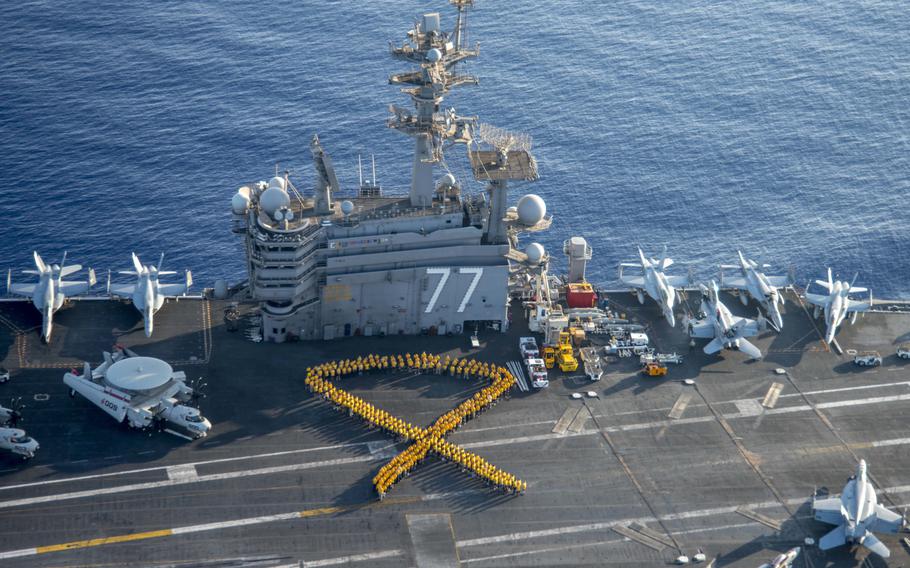
Sailors form a human ribbon on the flight deck of the aircraft carrier USS George H.W. Bush, July 22, 2017, in support of Suicide Prevention and Awareness Month. The Navy has no way of knowing whether commanders are following the requirement to create a suicide crisis prevention plan or whether existing plans are adequate, the Defense Department Inspector General found. (Daniel Gaither/U.S. Navy)
NAPLES, Italy — The Navy has no way of knowing whether its commanders have created a suicide crisis plan as mandated by the service in the face of persistently alarming numbers of sailor suicide deaths, a Defense Department Inspector General audit found.
That’s because the service lacks a dedicated office to track the plans and ensure that they include essential elements, such as mental health resources and contact information, the agency said in a report released Tuesday.
“Commands may not have the procedures in place to respond appropriately in a timely manner to a sailor in crisis, validate that lethal means of suicide are restricted and ensure that sailors in crisis have sufficient oversight,” the report stated.
The Navy has struggled for more than a decade with rising suicides, as underscored by three USS George Washington sailors who killed themselves during one week in April 2022 as the aircraft carrier was undergoing extended maintenance.
That year, 71 active-duty and seven reserve sailors, respectively, took their lives, according to Navy statistics. In 2023, 68 active-duty and eight reserve sailors died by suicide.
The service has worked to better identify and help sailors at risk, including significantly increasing its suicide prevention budgets for 2024 and 2025, according to the report.

Anti-suicide pleas are displayed at an event at Portsmouth Naval Shipyard, Maine, Sept. 25, 2024. The Navy has no way of knowing whether its commanders have created a suicide crisis plan as mandated by the service, according to a new Defense Department Inspector General report. (Branden Bourque/U.S. Navy)
But of 277 commanders in U.S. Fleet Forces Command and U.S. Pacific Fleet surveyed by the DOD IG, 39 did not have a local crisis response plan, according to the report.
An additional 38 said they had a plan but did not submit it for review, and two more did not answer questions about whether they had a plan, the DOD IG said.
The Navy pushed back on the finding that a lack of a central oversight office was to blame.
Establishing such an office is impractical and would undermine a commander’s authority and responsibility as well as pose an undue burden on the fleet, said Rear Adm. Jay Clark, director of the Navy’s Culture and Force Resilience Office.
“In this specific case, centralized reporting for crisis response plans would do little to ensure a command’s ability to effectively respond in a crisis,” Clark said in a March 19 response to the report.
Clark agreed that having the plans is critical and that they “should be treated with the same level of care as warfighting tactic, technique or procedure.”
The Navy will continue to emphasize the importance of crisis response to its commanders and update its policy to better highlight their responsibilities, he said.
The review included 277 survey responses from commanding officers, of whom 198 submitted their local crisis plans for evaluation. Nearly half of those plans did not include a reporting requirement to the Sailor Assistance and Intercept for Life, or SAIL, program, according to the report.
The program provides rapid assistance, ongoing risk assessment, care coordination and reintegration assistance for active-duty sailors, according to the Navy.
A total of 21% of the submitted plans did not have a list of mental health resources and contact information and 6% were not specifically tailored to their commands, according to the report.
The DOD IG required Clark to provide additional comments within 30 days, noting that its recommendation for the oversight office remained open and unresolved.
In addition to recommending the establishment of the central office, the DOD IG also advised the Navy to develop and implement a plan to ensure all commands have a completed local crisis plan.
The Navy’s Culture and Force Resilience Office agreed with that recommendation.